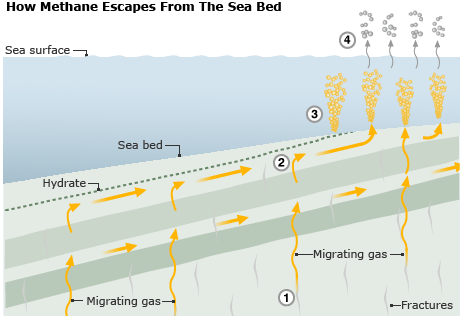By Judith Burns
Science and environment reporter, BBC News

methane plumes
Methane bubbles observed by sonar, escape from sea-bed as temperatures
rise
Scientists say they have evidence that the
powerful greenhouse gas methane is escaping from the Arctic sea-bed.
Researchers say this could be evidence of
a predicted positive feedback effect of climate change.
As temperatures rise, the sea-bed grows warmer
and frozen water crystals in the sediment break down, allowing methane
trapped inside them to escape.
The research team found that more than 250
plumes of methane bubbles are rising from the sea-bed off Norway.
The joint British and German research team
detected the bubbles using a type of sonar normally used to search for
shoals of fish. Once detected, the bubbles were sampled and tested for
methane at a range of depths.
Writing in Geophysical Research Letters,
the team says the methane was rising from an area of sea-bed off West Spitsbergen,
from depths between 150m and 400m.
The gas is normally trapped as "methane hydrate"
in sediment under the ocean floor.
METHANE HYDRATES
* Methane gas is trapped inside a crystal structure of water-ice
* The gas is released when the ice melts, normally at 0°C
* At higher pressure, ie under the ocean, hydrates are stable at higher
temperatures |
"Methane hydrate" is an ice-like substance
composed of water and methane which is stable under conditions of high
pressure and low temperature.
As temperatures rise, the hydrate breaks down.
So this new evidence shows that methane is stable at water depths greater
than 400m off Spitsbergen.
However, data collected over 30 years shows
it was then stable at water depths as shallow as 360m.
Ocean has warmed
Temperature records show that this area of
the ocean has warmed by 1°C during the same period.
The research was carried out as part of the
International Polar Year Initiative, funded by Britain's Natural Environment
Research Council (Nerc).
The team says this is the first time that
this loss of stability associated with temperature rise has been observed
during the current geological period.
Professor Tim Minshull of the National Oceanography
Centre at Southampton told BBC News: "We already knew there was some
methane hydrate in the ocean off Spitsbergen and that's an area where climate
change is happening rather faster than just about anywhere else in the
world."

How Methane Escapes From The Sea Bed
Infographic (BBC)
1. Methane hydrate is stable below 400m
2. Nearer the surface the hydrate breaks down as temperatures
rise and the methane is released
|
suite:
3. Gas rises from the sea-bed in plumes of bubbles
- most of it dissolves before it reaches the surface
4. So far scientists haven't detected methane breaking
the ocean surface - but they don't rule out the possibility
"There's been an idea for a long time that
if the oceans warm, methane might be released from hydrate beneath the
sea floor and generate a positive greenhouse effect.
"What we're trying to do is to use lots
of different techniques to assess whether this was something that was likely
to happen in a relatively short time scale off Spitsbergen."
However, methane is already released from
ocean floor hydrates at higher temperatures and lower pressures - so the
team also suggests that some methane release may have been going on in
this area since the last ice age.
Significant discovery
Their most significant finding is that climate
change means the gas is being released from more and deeper areas of the
Arctic Ocean.
Professor Minshull said: "Our survey was
designed to work out how much methane might be released by future ocean
warming; we did not expect to discover such strong evidence that this process
has already started.
We were slightly surprised that if there
was so much methane rising why no one had seen it before. But I think the
reason is that you have to be rather dedicated to spot it because these
plumes are only perhaps 50m to 100m across.
The device we were using is only switched
on during biological cruises. It's not normally used on geophysical or
oceanographic cruises like ours. And of course you've got to monitor it
24 hours a day. In fact, we only spotted the phenomenon half way through
our cruise. We decided to go back and take a closer look."
The team found that most of the methane is
being dissolved into the seawater and did not detect evidence of the gas
breaking the surface of the ocean and getting into the atmosphere.
The researchers stress that this does not
mean that the gas does not enter the atmosphere. They point out that the
methane seeps are unpredictable and erratic in quantity, size and duration.
It is possible that larger seeps at different
times and locations might in fact be vigorous enough to break through the
ocean surface.
Most of the methane reacts with the oxygen
in the water to form carbon dioxide, another greenhouse gas. In sea water,
this forms carbonic acid which adds to ocean acidification, with consequent
problems for biodiversity.
Graham Westbrook, lead author and professor
of geophysics at the University of Birmingham, said: "If this process
becomes widespread along Arctic continental margins, tens of megatonnes
of methane a year - equivalent to 5-10% of the total amount released globally
by natural sources, could be released into the ocean."
The team is planning another expedition next
year to observe the behaviour of the methane plumes over time. They are
also engaged in ongoing research into the amount of methane hydrate under
this area of the ocean floor.
Ultimately, they want to be able to predict
how much might be vulnerable to temperature change and in what timescale. |

